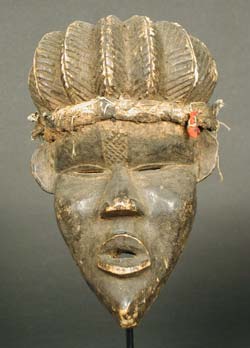Bassa Wooden Dance Mask, 20th Century CE
Wood and Mixed Media
6.75 x 10.5
PF.4808
Further images
Both men's and women's societies of the Bassa use masks. The men's society, “Naw,” perform a mask known by the same name. The term “Naw” is impossible to translate and...
Both men's and women's societies of the Bassa use masks. The men's society, “Naw,” perform a mask known by the same name. The term “Naw” is impossible to translate and is usually glossed in Liberian English as "devil," a general term used for men's societies and for all masked performers. The mask is also frequently called a “Gela,” which means "Big Spirit". The “Naw” or “Gela” mask may be present at closed meetings restricted to initiated members of the men's societies as well as at open, festive occasions where anyone may see it. Its performance consists of an exceptionally smooth, gliding dance to the music of slit drums; dancers move rapidly (even over rough terrain), as if floating on a cushion of air. Occasionally the performance has been referred to as the "Bassa Hovercraft" (Ross 1994). The facial part of the mask is normally a little smaller than a human face and is attached obliquely to a rattan basketry, cap-like structure. Thus, the wearer does not see out through the eyes, even when they are carved through, but rather sees through a slit in the cloth that is suspended beneath the mask and the headdress.
The features of the mask, like its movements, are refined, graceful, and generally regarded as feminine. Consequently, the spirit force of a genderless order, it is simultaneously thought of as having feminine attributes. The eyes, which are narrow, half-closed, and close set, as well as the elaborate forms, match Bassa's canons of beauty; the vertical pattern on the forehead represents a traditional tattoo.
The features of the mask, like its movements, are refined, graceful, and generally regarded as feminine. Consequently, the spirit force of a genderless order, it is simultaneously thought of as having feminine attributes. The eyes, which are narrow, half-closed, and close set, as well as the elaborate forms, match Bassa's canons of beauty; the vertical pattern on the forehead represents a traditional tattoo.







